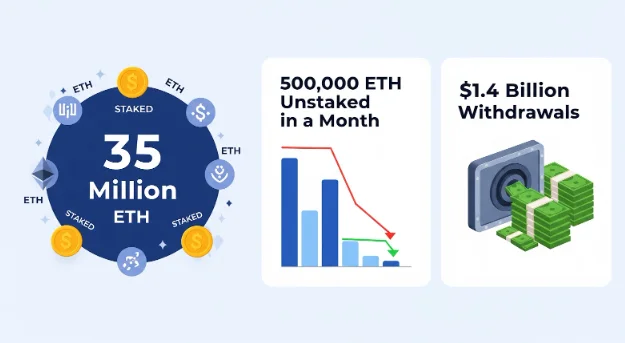The Ethereum network has witnessed a historic shift: over $48 billion in staked ETH is becoming liquid, raising concerns about potential sell pressure and its impact on Ethereum price prediction. As staked ETH enters wallets and exchanges, analysts are closely evaluating whether this will trigger a bearish cascade or signal renewed investor confidence. This article breaks down the phenomenon, highlights key developments, and offers insight-driven considerations for ETH holders and traders.
1. Staking Statistics: A Record Unlock Event
Current data indicates that nearly 35 million ETH or roughly 28.7% of the circulating supply, are now staked via Ethereum’s proof-of-stake mechanism. Liquid staking protocols like Lido account for nearly a third of that, with institutional players following close behind.
Following the Shanghai/Capella upgrade, stakers can now withdraw their previously locked-up ETH rewards and principal. Weekly withdrawals have surged, with more than 500,000 ETH unstaked just in the past month, which is equivalent to approximately $1.4 billion. Various platforms have even recorded single-day withdrawals exceeding 120,000 ETH.
2. Exchange Flows and On-Chain Behavior
On-chain data shows significant net outflows from centralized exchanges; over 140,000 ETH exited in a single day, suggesting long-term holders are moving assets off exchanges rather than preparing to sell.
Whale movements paint a more nuanced narrative. Recent flows to exchanges, especially from high-balance addresses that have coincided with significant liquidations and price dips . Such activity suggests rising short-term sell pressure, even if total withdrawals may ultimately support accumulation narratives.
3. Sell Pressure Scenarios: Modeling the Downside
Industry analysts, including Nansen and Glassnode, have published forecasts evaluating post-withdrawal sell-side pressure:
- Nansen estimates between $1.9–$4.6 billion of selling pressure over several weeks, depending on how much liquid ETH is sent to exchanges.
- Glassnode’s February 2023 study projected around 0.3–1.5 million ETH becoming liquid in three phases post-Shanghai, with only a fraction likely to hit markets immediately.
The consensus? Even the most aggressive sell-off scenarios represent less than average weekly exchange inflows, suggesting structured liquidation events may not drastically disrupt price, assuming sustained demand and consumption persist.
4. Challenges and Dynamics at Play
While the wave of staking withdrawals unlocking nearly $48 billion in ETH, hasn’t triggered a sudden price crash, several significant challenges remain:
Centralized Liquid Staking Risk
A large share of staked ETH is managed via liquid staking protocols like Lido, followed by major centralized players. If a critical mass of these platforms chooses to unstake simultaneously, it could create a concentrated exit event and temporary sell pressure.
Profit-Taking Behavior
As ETH prices have risen, more stakers find themselves “in the money.” Nansen’s data shows approximately 60% of all staked ETH is currently profitable. This profitability creates a psychological trigger; stakers may be tempted to cash in, driving some withdrawal inflows and potential sell pressure.
Withdrawal Speed Limits
Ethereum’s protocol enforces limits on validator exits. About 800 exits per day, corresponding roughly to 50k ETH. This throttling mechanism spreads any sell pressure over days or weeks, helping prevent a sudden dump, but it also introduces timing uncertainty for both buyers and sellers.
Macro-Market Volatility
If withdrawals coincide with broader crypto or global market stress, such as sharp equity losses or macroeconomic shocks, even small ETH outflows may exacerbate price drops. Recent data shows weekly withdrawals of $1.4B across exchanges as an indicator that liquidity may tighten in turbulent conditions.
Network Revenue Drop
Lower protocol fee revenue from Ethereum’s Layer-1, especially post-Dencun, has reduced the network’s earnings sharply. While this does not directly drive sell pressure, it may limit incentives and infrastructure investment factors that indirectly affect market sentiment.
5. Strategic Insights for ETH Investors
- Monitor Exchange Inflows: Establishing a connection between staking withdrawals and rising exchange deposits is key to spotting incoming sell pressure.
- Track Profitability Trends: With over 60% of addresses in the money, ETH could see consolidations and retracements if holders choose to cash out.
- Consider Timing of Withdrawals: The gradual exit queue means that buying opportunities may present themselves over weeks, not instantly.
- Diversify Staking Exposure: To reduce centralization risks, investors might split staking among Lido, Rocket Pool, and direct validator setups.
- Incorporate into Price Models: Ensure Ethereum price prediction models include releasing supply and buffered signs of macroeconomic and technical demand.
Conclusion
The current wave of staking withdrawals, driven by the unlocking of nearly $48 billion in staked ETH, poses a mixed picture. While some of the liquid supply may find its way onto exchanges, reducing short-term sell pressure, much is likely to stay locked or used in DeFi.
Sell pressure estimates suggest manageable impacts within historical norms. However, upsized exit waves coinciding with systemic events or macro-market stress could test ETH’s near-term price resilience.
Looking ahead, Ethereum price prediction models will need to balance structural adoption trends like spot ETF demand and broader staking with dynamic liquidity shifts. For ETH investors, agility in spotting withdrawal patterns and comprehension of staking infrastructure will be essential in navigating this evolving landscape.
